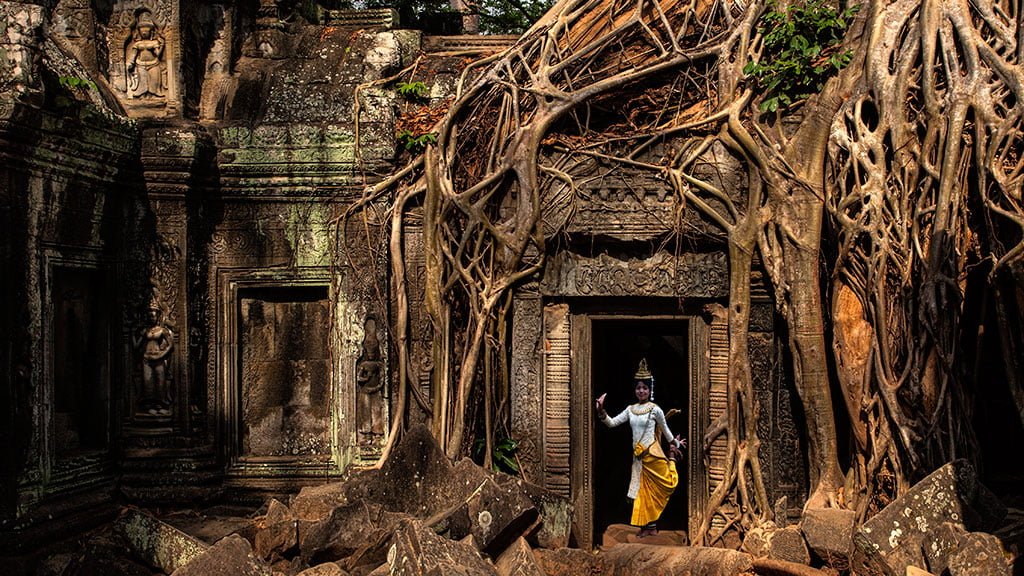Ta Prohm: Cambodia's Ancient Wonder
Hey readers! No more waiting for my blogs; I'm here with the latest one as it's a new week! I'm back to unwrap a new story that will surely hook you till the end. Today, I thought to enlighten you with an archaeological and architectural historical fact about a temple in Cambodia known as Ta Prohm. Sounds interesting, doesn't it? So without wasting a minute, let's explore what Ta Prohm has for us.
The temple is located in Siem Reap, Cambodia, in the city of Angkor. The creation of Ta Prohm dates back to the late 12th and 13th centuries, during the reign of Jayavarman VII, who was known as the most powerful leader of the Khmer dynasty.
The kings of the Khmer dynasty ruled and centralized mostly in the city of Angkor. They were known as one of the largest, highly prosperous, and most sophisticated civilizations in the history of Southeast Asia. King Yashovarman I of Angkor established his residence in the latter part of the 9th century. From then until the early 13th century, the kingdom's rulers governed over an area stretching from the tip of the Indochinese Peninsula northward to modern-day Yunnan province, China, and from Vietnam westward towards the Bay of Bengal.
Numerous changes took place both in artistic and architectural styles in Angkor. Alongside a religious transition occurred from the Hindu cult of Lord Shiva towards Lord Vishnu. Gradually, in the direction of Mahayana Buddhist cult devoted to the Bodhisattva Avalokiteshvara.
Jayavarman VII started off in 1186 AD, with the mission of originating Rajavihara now known as Ta Prohm. The term Rajavihara translates into ‘Monastery of the King’. It is regarded as one of the earliest temples established under that initiative. According to the stele marking the foundation, it was founded in 1186 A.D.
The initiative of constructing Rajavihara is honoring his family. Ta Prohm is signifying the representation of Prajnaparamita, the personification of wisdom, sculpted as the king’s mother. The king's guru, Jayamangalartha, and his elder brother were the subjects of the outlying temples located in the third perimeter to the north and south, respectively. Like that, Ta Prohm and Preah Khan's temple monastery, built in 1191 A.D., whose principal picture depicted the Bodhisattva of benevolence Lokesvara and had its roots on the king's father, made a complimentary pair.
Ta Prohm was built as a university and Buddhist monastery. It functioned as a hub for Buddhist worship, guidance, and meditation as a place of worship. The purpose of the temple complex was to house academics, monks, and devotees seeking religious education and spiritual enlightenment. Ta Prohm represented patronage and royal authority as well. In order to prove the legitimacy of his reign and the power of his lineage, King Jayavarman VII commissioned the building of Ta Prohm. Ruling families were able to show their devotion and win over both the Buddhist clergy and the general public by establishing and furnishing temples such as Ta Prohm.
According to the stele found there, over 12,500 people lived in the temple (including 18 high priests and 615 dancers). An further 80,000 people lived in the nearby towns, where they worked as servants and suppliers. The stele also mentions the temple's enormous wealth, which included silks, jewels, and gold. Even during Srindravarman's reign at the end of the 13th century, Ta Prohm was added to and expanded upon.
The structure and architecture of the temple provide important insights into the worldview and social structure of the Khmer people by reflecting their cosmological ideas and religious rituals.
Unlike a temple-pyramid or temple-mountain, whose interior levels are taller than their outer ones, Ta Prohm's architecture is characteristic of a "flat" Khmer temple. Around a centre sanctuary are five rectangular surrounding walls. The embodiment of knowledge, Prajnaparamita, in the shape of the king's mother, is the focal point of the shrine. The actual temple of Ta Prohm is positioned back to the west along an extended east-west axis because, like the majority of Khmer temples, it faces east. The 650,000 square metre area enclosed by the outer wall, measuring 1000 by 650 metres, was formerly home to a sizable town but is now mostly covered in forest.
Though entry is presently accessible only from the east and west, there are entryway gopuras at each of the cardinal positions. The gopuras had face towers added to them in the 13th century, modeled after those at the Bayon. A few of the facial towers have fallen. Moats used to be present both outside and within the fourth enclosure. Due to the existence of two moats, some historians have conjectured that the 12th and 13th ruins of Ta Prohm are an extension of an older Buddhist shrine located on the same location.
The central sanctuary tower and the corner towers of the first enclosure create a quincunx with the three inner enclosures of the temple itself. The visitor's experience is further complicated by the numerous structures scattered across the site, some of which are later additions, and the convoluted route required by the partially collapsed state of the temple. The libraries located in the southeast edges of the first and third enclosures, the satellite temples situated on both the north and south sides of the third enclosure, the Hall of Dancers situated within the third and fourth eastern gopuras, and the House of Fire situated east of the fourth eastern gopura are the most notable of these other structures.
Compared to Angkor Wat or Angkor Thom, Ta Prohm has fewer narrative bas-reliefs. In any case, there are still some representations of Buddhist mythological scenes. A severely deteriorated bas-relief depicts the "Great Departure" of the future Buddha, Siddhartha, from his father's palace. The temple also has stone reliefs of meditating monks or ascetics, dvarapalas, or temple guardians, and devatas, or little feminine goddesses.
 |
| The Great Departure of Siddharta |

A bas-relief over an entrance at Ta Prohm includes this intense
meditating or praying figure
Perhaps Ta Prohm's most defining feature is the trees that sprout out of the ruins; these trees "have prompted more writers to descriptive excess than any other feature of Angkor." There are two main species, however different sources identify them differently: the bigger one is either Tetrameles nudiflora or the silk-cotton tree (Ceiba pentandra), while the smaller one is either the gold apple (Diospyros decandra) or the strangler fig (Ficus gibbosa). Maurice Glaize, an Angkor historian, remarked, "On every side, in fantastic over-scale, the trunks of the silk-cotton trees soar skywards under a shadowy green canopy, their long spreading skirts trailing the ground and their endless roots coiling more like reptiles than plants."
The temple of Ta Prohm lay neglected and deserted for centuries following the fall of the Khmer Empire in the fifteenth century. As a "concession to the general taste for the picturesque," the École française d'Extrême-Orient determined that Ta Prohm would be kept largely as it had been discovered when the project to save and rebuild the Angkor temples started in the early 20th century. Ta Prohm is considered to be "one of the most imposing [temples] and the one which had best merged with the jungle, but not yet to the point of becoming a part of it," according to renowned Angkor historian Maurice Glaize.Still, a great deal of work has gone into stabilising the ruins, allowing access, and preserving "this condition of apparent neglect."
To sum up, Ta Prohm's 1992 induction onto the UNESCO World Heritage List was a major acknowledgement of its historical and cultural significance. An example of international cooperation in preserving our common heritage is the partnership that followed between the Archaeological Survey of India and the APSARA Authority for its conservation and restoration.
The Archaeological Survey of India has successfully repaired numerous portions of Ta Prohm over decades of diligent work, including rebuilding pieces when necessary. Furthermore, the installation of wooden platforms, pathways, and roped railings has minimised damage caused by tourist activities while permitting people to appropriately enjoy the temple's beauty.
Ta Prohm is still a source of inspiration for conservationists throughout the world, since it is a living example of both the natural environment's tenacity and the Khmer civilization's inventiveness. We preserve Ta Prohm so that future generations might behold its breathtaking magnificence and pay tribute to the past.









Comments
Post a Comment